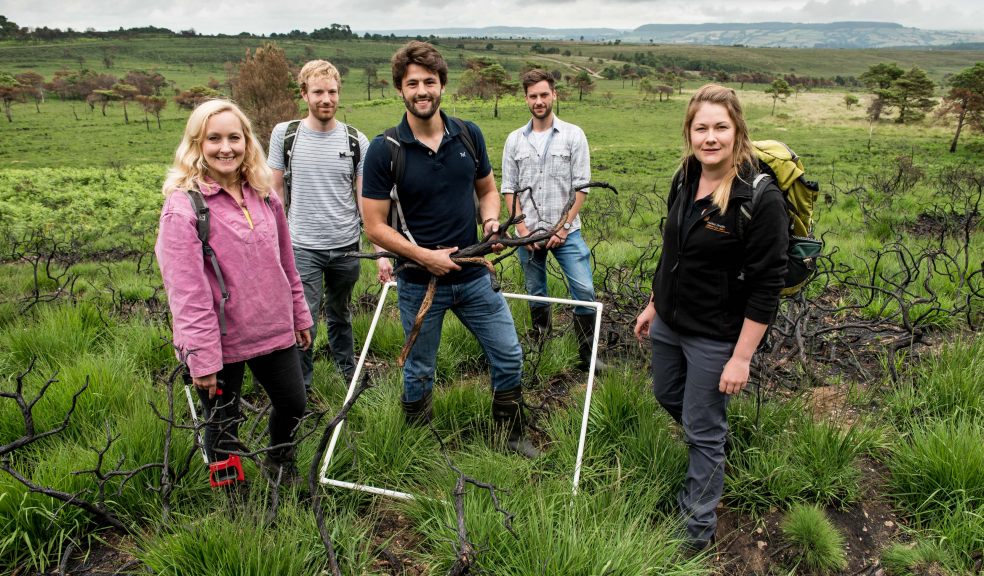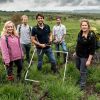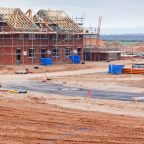
East Devon heathland wildfire site is focus of globally important research project
Clinton Devon Estates is supporting an internationally important research project into the effect of wildfires on global warming.
A team of University of Exeter scientists from the University’s wildFIRE lab is currently assessing the impact of a 50-hectare fire on the East Devon Pebblebed Heaths at Colaton Raleigh Common, owned by Clinton Devon Estates and managed by the Pebblebed Heaths Conservation Trust.
The group has been conducting weekly field visits to the site since the fire on April 23rd, which took 160 firefighters eight hours to extinguish.
Plants convert carbon dioxide in the atmosphere to energy during the process of photosynthesis, allowing them to grow and reproduce. The scientists’ mission is to determine what happens to the carbon held in plants when they burn, and in particular the overall effect of fire on atmospheric levels of carbon dioxide, a greenhouse gas that warms the earth’s atmosphere.
Ultimately, the team’s work will help determine the role and effect of wildfires globally, before they become more prevalent as temperatures rise and droughts become more frequent through global warming.
They are also examining whether there is credibility behind the hypothesis that wildfires have some long-term benefits for the earth’s climate.
Clinton Devon Estate’s Pebblebed Heaths Site Manager, Kim Strawbridge, said: “We are keen to support science and learning whenever possible so are really pleased to be able to work with Exeter University’s wildFIRE lab.
“Not only will this improve our understanding of the site’s recovery post fire, but it enables us to contribute to the wider understanding of fire in carbon cycling, informing internationally significant climate change research.”
PhD researcher Matthew Jones said that the recent wildfire on the Pebblebed Heaths presents a “unique” opportunity to investigate these questions because the fire affected an accessible area from which rainwater washes directly into a single stream flowing off the common.
“Wildfires affect around 350 million hectares of the earth’s land surface each year, 14.5 times the area of the UK, and are an important feature of many ecosystems, controlling plant growth and soil quality,” he explained.
“It is vital that we understand what happens to the carbon held in plants when they are burnt because this is set to become an increasingly important part of the carbon cycle as the earth warms.
“In particular, we want to determine how much carbon from the burnt vegetation ends up in the atmosphere as a greenhouse gas in the long term, and conversely, how much is converted to charcoal and soot and stored on land and in the ocean.
“This will help us determine the long-term effect that fires have on the concentration of carbon dioxide in the atmosphere, and the carbon cycle as a whole.”
Researchers are especially interested in understanding the long-term fate of carbon-rich charcoal produced by fires and whether it is stored for long periods in soils, transported by rivers and stored in oceans, or if it quickly degrades and is released as greenhouse gas.
Matthew explained: “If carbon-rich products produced by fire, such as charcoal, become buried in soil or transported to the oceans by rivers, then they are stored in places where they cannot degrade to carbon dioxide as quickly as when a plant dies naturally.
“And if the original vegetation is left to recover then the effect is that there are extra stores of carbon on land and in the ocean, that didn’t exist before the fire, and therefore less carbon dioxide in the atmosphere as a result of the fire.
“This effect continues for hundreds to thousands of years as the stable products of fire decompose very slowly.”
Assessment of the ecosystem’s recovery is another essential component of the research.
Dr Claire Belcher, who heads up the wildFIRE lab, added: “The varied nature of vegetation at the common, a mix of grassland, heathland and tree stands, makes it a perfect case study to analyse charcoal from across the site and monitor the ecosystem over time to see how species recover, or die.
“Some trees, such as pines, may have been protected from the flames by thick bark, while other individuals may have been killed by smouldering soil. By tracking how the ecosystem recovers at the common we can begin to understand the long-term implications of fire activity on carbon stocks and ecosystems.”
The team’s work is supported by a wealth of information about the environment and ecology of the common as a result of the management and monitoring activities of the Pebblebed Heaths Conservation Trust.
Progress can be tracked at www.wildfirelab.wordpress.com


















